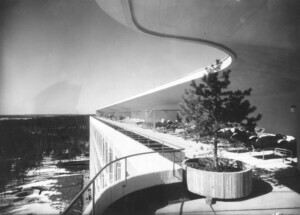Today in Montréal, 600 designers, architects, geographers, technology experts, entrepreneurs, and policymakers convened for the New Cities Summit, a forward-looking conference hosted by the New Cities Foundation. The Summit tries, through the lens of technology, to put a finer point “innovation,” “urban change,” and “economic growth,” often-nebulous concepts that nevertheless drive the design and governance of our cities.
Speakers, panels, round-tables, and workshops focus on using new technology to engage visitors in “thirdspaces” (where people neither work nor live), boosting the sharing economy through new (and old) means of engagement, finding solutions to a global affordable housing crisis, placemaking, and public art are held over a two-day period, followed by site visits around Montréal.
The Architect’s Newspaper (AN) attended the summit when it was held in Dallas, in 2014, but this is the first time AN is attending the event internationally. Follow @archpaper in Montréal for live updates on Twitter, Instagram, Facebook, and Snapchat (archpaper).
The opening panel, “The Age of Urban Tech,” moderated by Estelle Métayer, founder and principal of Competia, featured four city leaders in the private and public sectors: Chiara Corazza, managing director of the Greater Paris Investment Agency; Anil Menon, president of Smart and Connected Cities and the deputy chief globalization officer at Cisco (a conference sponsor); Alexandre Taillefer, managing partner of XPND Capital and the founder of Téo Taxi; and Ivy Taylor, the mayor of San Antonio, Texas.
Métayer opened with a broad question on the role of technology in the 21st century city, and panelists, despite their mostly tech-centric backgrounds, were keen on both the appeal of (and limits to) apps and hacks. At each fork in the discussion, the panelists turned back to the importance of using technology to enhance existing communities. “The best and worst thing is that people are focused on technology. [The] focus should be on urban experience, not on the technology. Technology should be invisible and should maintain and enhance the quality of life,” Menon noted.
Speaking of her city, Taylor explained that “people are the heart of cities we serve.” San Antonio, population 1.4 million, is seventh largest city in the U.S. and is 60 percent Latino. She emphasized that closing the digital divide, especially though education and neighborhood engagement, is key to not leaving the most vulnerable residents behind, especially in an an era where cities compete directly with one another for resources and capital.
Building on Taylor’s observations, Taillerfer underscored the importance of adapting technology to current users with a homegrown example: A taxi company on east side of Montréal receives 90 percent of its calls via an old-fashioned phone. In that district, only twenty percent of residents use smartphones. Education and access can bring users up to speed on smartphones, but the current means of calling the taxi must be consistent with the current knowledge base.
Taillefer urged participants to be wary of the role of corporations in shaping public tech projects. “A lot of innovations require a lot of capital, so cities have to be careful about the deals [we] sign with corporations. Tech,” she declared, “is fun, but we need to take into account the lives of citizens.”
Sharing information transparently is key to having that fun and sustaining trust. Taylor noted that when body cameras for police officers were introduced in San Antonio, at first there wasn’t enough communication about the new technology. Consequently, public misunderstandings and resentments arose around the cameras. “We’re still on front end of conveying public what access to information will be, how quickly information will be processed,” said Taylor.
For all the conversation around anti-union sentiment in tech, Menon grounded the discussion in the importance of sustaining local entrepreneurs while engaging labor unions. “Unions represent the current middle class who are deeply suspicious of new tech because it’s seen as replacing jobs.” Public and private-sector unions, he argued, need to establish new ways to work with corporations. He cited Germany as an example of a country that has both strong economic growth and union representation.
For all the barriers, there was profound optimism among panelists that cities will look radically different in the next five to ten years because of new technologies. Corazza, Taylor, and Taillerfer highlighted public transit innovations as a key locus of innovation (Taillerfer: “I dream of the day you pay $250 per month for access to multimodal, anti–private car transit for everything) while Menon cited video internet and, surprisingly, liquid biopsy, a form of data collection to detect and treat cancer. Who knew?










